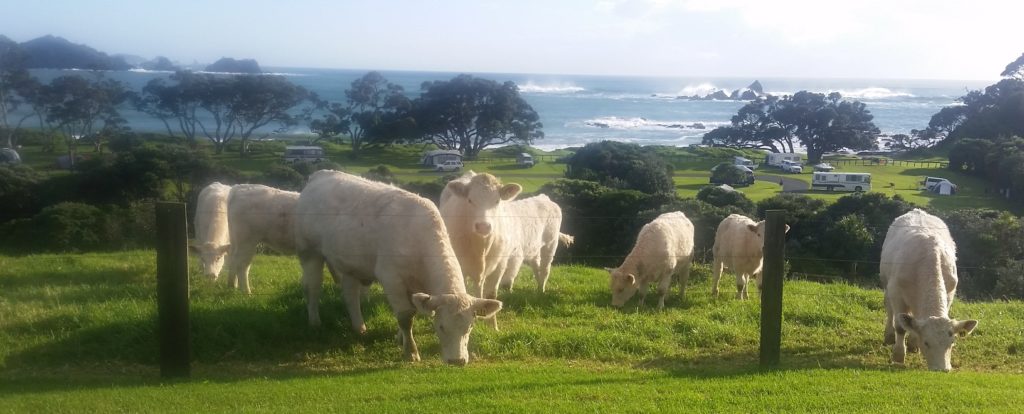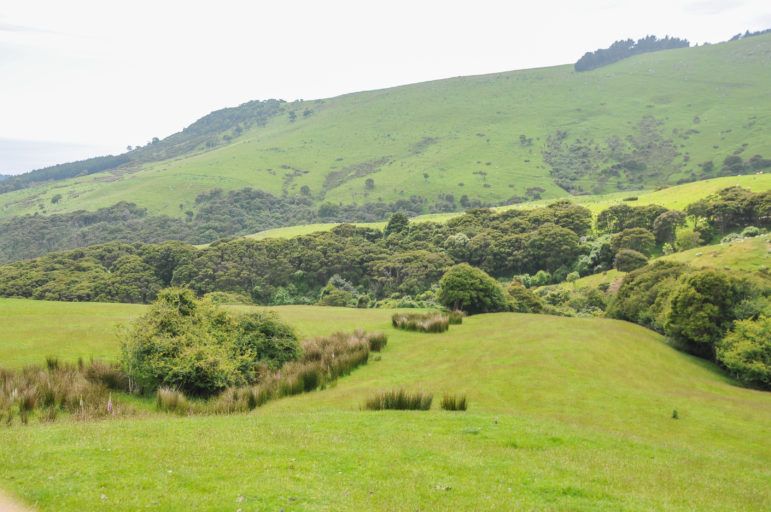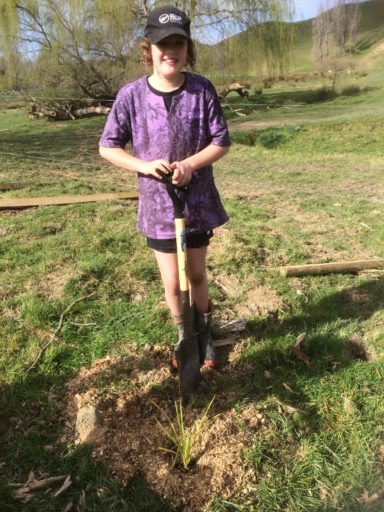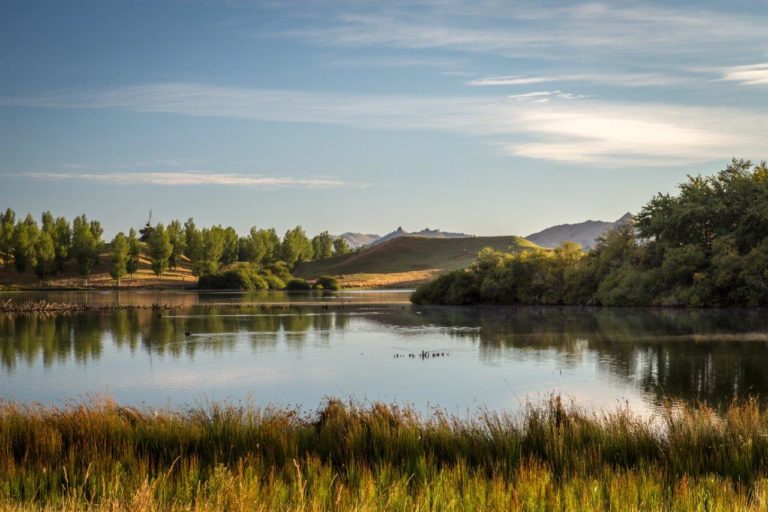‘Rules stifle innovation,’ say researchers looking at how we can achieve win-win outcomes for pastoral farming and biodiversity conservation in New Zealand.

“To obtain win-win outcomes for biodiversity conservation, pastoral farming and New Zealanders generally, we need to avoid letting our policy systems (national, regional and district) fall back on a strict rules-based approach. This tends to stifle innovation and result in perverse outcomes. We need to reorganise our policy system to incentivise and reward farmers for good biodiversity management which includes looking after remnants of forest and wetlands, and regenerating native forest and shrubland, and improving connectivity through landscape-level integration.”
In their article, recently published in the New Zealand Journal of Ecology, David Norton et al explore options to enhance native biodiversity conservation within New Zealand pastoral agroecosystems while also optimising primary production.
“We believe that there is strong synergistic interdependence between biodiversity conservation and pastoral farming that is not well recognised, and that it is possible to have win-win outcomes for both in New Zealand. However, to do this we suggest the need for a fundamental shift both in our farming systems and in the way we implement and support biodiversity management and enhancement. This shift needs to be away from traditional thinking where biodiversity conservation or pastoral farming are viewed as a dominant land management objective on their own to one where they are spatially integrated and complement each other.”
The authors focus primarily on forested ecosystems, reflecting how our landscape used to be.

“With the exception of parts of the eastern South Island high country, forest was the predominant pre-European vegetation cover in the areas where pastoral farming now occurs. Pastoral farming is the dominant land use in New Zealand, occupying at least half of the land area (40% sheep and beef, and 10% dairy), and is a critical part of the New Zealand economy contributing 36% and 38% of export earnings (including international tourism) in 2017 and 2018 respectively. Pastoral farming occurs primarily at lower elevations where loss of original habitat has been greatest and where there is little public conservation land, although significant remnants of native vegetation still remain.”
The same temperate climate, rainfall and fertile soils that once favoured diverse native forests also make these areas ideal for farming. But the heat is on landowners to reduce pastoral farming’s environmental footprint.
“Substantial concerns have been raised about the impact of farming systems (especially high intensity dairy farming) on water quality and the contribution of grazing animals to greenhouse gas emissions, especially biogenic methane.”
So how can we manage farming and biodiversity in mutually beneficial ways?
“Land sparing and land sharing have been proposed as two ways of conceptualising how we might manage biodiversity within agroecosystems, although the consensus seems to be that both are likely to be important, especially because land set aside for biodiversity conservation under the land sparing model is vulnerable to future impacts.”
Farmland is fundamentally different to public conservation land.
“The composition, structure and spatial arrangement of native biodiversity in those parts of New Zealand where pastoral agroecosystems dominate is different to those in areas with extensive public conservation lands. With some exceptions, native habitats tend to be small, isolated, and modified to varying degrees by grazing (domestic and feral), historic logging, plant invasions and edge effects resulting in changes to their composition and structure.”
“While some of these native habitats are protected through covenants or as part of the public conservation estate, most do not have any formal protection. The fragments of native habitat that occur comprise both remnants of the original forests and regenerating vegetation that has established on sites that were previously farmed. Woody native vegetation can range from a continuous native canopy to scattered trees through a paddock. Notwithstanding its fragmented and isolated nature, a surprisingly large amount of native biodiversity remains across pastoral landscapes in rural New Zealand, including many nationally and regionally rare plant and animal species.”
So, fragmented or not – farmland remnants are well worth protecting and restoring – the issue is how best to go about it.
“As is the case on public conservation land, many native plants, birds, lizards and invertebrates are in decline in pastoral agroecosystems because of the ongoing effects of predation pressure, as well as the legacy effects of fragmentation (loss of resources and landscape connectivity). Nonetheless, the remaining native biodiversity that is present in pastoral landscapes is critically important across extensive areas of lowland New Zealand because these remnants are often all that remains of the original pre-human ecosystems.”
New Zealand farming systems are still largely grass-based and range from relatively extensive, low-input systems to high-input intensive farming. But intensification isn’t always a bad thing, the authors point out.
Intensification across a range of landscapes, but especially associated with dairy farming, has resulted in reductions in stream flows, increases in nutrient discharges into streams and groundwater, and eutrophication of wetlands. However, in some farming systems intensification has actually improved environmental outcomes. For example, the shift from flood irrigation (wild flood and border dyke) to pivot irrigation on some pastoral farms has led to improved environmental outcomes for these systems due to less overland flow resulting in a decrease in leaching losses and nutrient concentrations in receiving water bodies.”

Climate change concerns and carbon credits are also influencing how land is managed.
“With an increasing focus on the effects of climate change, the One Billion Trees Programme (Te Uru Rākau 2018), the New Zealand Government’s target of being carbon-zero by 2050, and a predicted rising value of carbon credits, trees may become a more attractive investment for some sheep and beef farms than traditional farming. These more recent policy initiatives have triggered another shift from sheep and beef farming to exotic plantation forestry for carbon credits with suggestions that as much as 30 000 ha in the eastern North Island has been converted in 2018–19.”
Then there are the impacts of regulations.
“District and regional councils are increasingly regulating farmers in terms of how they interact with biodiversity, primarily through the use of planning tools, including restrictions on vegetation clearance, pastoral intensification, and riparian management. Several district and regional councils now require farmers to have farm environment plans that include biodiversity in order to obtain or retain resource consents for a variety of on-farm management activities (e.g. irrigation, fertiliser application, vegetation clearance). Central Government has recently released a draft National Policy Statement for Indigenous Biodiversity which proposes even stricter requirements on farmers in terms of indigenous biodiversity.”
There is also increasing recognition within the farming sector of the need to prove its environmental credentials as part of its social licence to operate.
“Many individual farmers are responding positively through retiring bush and wetland areas from farming and in some cases covenanting them. However, covenants (mainly through the QEII National Trust) only account for 3% of the total area of native vegetation on sheep and beef farms. The One Billion Trees programme offers further incentives for farmers to integrate trees into their landscape by helping fund land retirement, fencing and the planting of native species.”
The authors believe that landowners need to be incentivised and rewarded for good biodiversity management, rather than relying on a strict rules-based approach.
“Can we better integrate biodiversity conservation and pastoral farming? The answer is yes, but to do this we suggest a rethink of the approach towards both biodiversity conservation and pastoral farming in rural landscapes is required; each depends on the other, addressing one in isolation will not result in a sustainable future for either. In developing a new future for pastoral farming and biodiversity conservation, we need to address some fundamental issues:
(1) Conservation groups and the wider New Zealand public need to trust that, if properly incentivised, valued and resourced, farmers are the best stewards of native biodiversity on their land.
(2) It is important that farmers recognise that there are many groups and individuals outside their farms who have an interest in and expertise about biodiversity across pastoral agroecosystems and want to help (directly or indirectly) achieve positive biodiversity outcomes on farms. Trust needs to work both ways.
(3) To make biodiversity conservation economically viable in agroecosystems we need to focus on producing value-added products that can be differentiated, marketed, verified and sold based on their method of production and on their environmental/biodiversity story. The current Beef+Lamb NZ campaign “Taste Pure Nature” is a good example of this.
(4) In developing a new future for pastoral farming and biodiversity conservation, contributions [are needed] from all the different groups involved (private sector, consumers, land managers, local communities, Māori, policy makers) to create enabling conditions for this and to scale up to regional and international markets.
(5) Finally, we need to enhance the current and proposed (through the National Policy Statement for Indigenous Biodiversity) regulatory approach to managing biodiversity in agroecosystems taken in District and Regional Plans, by incentivising and rewarding farmers for their biodiversity conservation actions. Such changes to the current approach need to be based on trust, partnership and collaboration.
It’s not enough just to protect areas legally.
“To achieve win-win outcomes we need to better target biodiversity management on farms, do our farming smarter and provide genuine support for farmers in implementing biodiversity management on their farms. Simply protecting these areas legally or even just fencing them off is not, however, sufficient to guarantee their viability. What is required is the implementation of management practices in remnants and regenerating vegetation to enhance them so that native biodiversity flourishes.”
“Management of remnants, regenerating vegetation and restoration requires plant and animal pest control, especially of herbivores and omnivores (deer, goat, pig, possum), as well as consideration of interactions between different land uses (e.g. fertiliser drift). However, addressing predation (carnivore) pressure alone without enhancing resources and increasing connectivity is insufficient for biodiversity conservation and will not result in enhancement of all native biodiversity in agroecosystems, especially of mobile species such as birds.”
Biodiversity conservation could be improved through land sparing (taking land out of production for restoration) but can also occur within the farmed landscape itself.

“Enhancing and conserving biodiversity might involve using a different mix of species for woodlots, erosion plantings and shelterbelts, retaining and planting scattered native trees in paddocks, shrub retention (e.g. matagouri), ensuring that year-round food supplies are available for native birds and invertebrates (including exotic tree sources), and taking advantage of recent advances in precision agriculture to minimise farming impacts on areas of native habitat. The key is taking a landscape-scale perspective on farming and biodiversity conservation, making sure that farming is undertaken in a manner that is friendly to biodiversity (land sharing), and recognising that much of this native biodiversity can directly benefit farming through shelter, shade, soil retention and nutrient management.”
Farming smarter is important too.
“Underpinning our biodiversity management, continuing to get smarter with how we farm is equally as important. This needs to include matching the right animals, grazing practices and forage plants to the right parts of the farm. Adopting or enhancing some of the ideas of regenerative agriculture within our farming systems (minimising cultivation, maintaining good ground cover, more diverse pastures and use of deeper-rooted species) are also likely to be important for the future of pastoral farming in New Zealand.”
The next step is to add value to products before they are exported.
“The success of the NZ Merino Company in taking an historically low value commodity (wool) and adding significant value to it, initially with fine wools but increasingly now with coarser wools, is testament to what can be achieved. A critical part of that added value in the eyes of discerning customers and consumers is New Zealand’s distinct brand story of which biodiversity and extensive pastoral farming’s role in that plays a starring role.”
The establishment of an integrated New Zealand-wide independent verification system that focuses on biodiversity outcomes and shows that farmers are actually doing the things they say they are doing is vital for being able to sell value-added farm products based on our environmental story to the world market.
“Development of a biodiversity support resource is critical for achieving the win-win outcome model proposed here and needs to be based on well-developed (online) extension resources, supported by independent biodiversity experts (biodiversity ambassadors) who take this information out to the farming community (farmers and farm advisors).”
“We suggest that if we change the way we think about how farming and biodiversity interact, then we will achieve substantial biodiversity gains across the 50% of New Zealand under pastoral farming. This then brings integrity to the existing and expanding market story for pastoral farming and creates a stronger connection between all New Zealanders and the farming sector. Advancing our thinking in this way will enable New Zealand to maintain a premium for our farming products internationally while supporting conservation of our native biodiversity.”
The full article is published in the New Zealand Journal of Ecology and is freely available online.
Achieving win-win outcomes for pastoral farming and biodiversity conservation in New Zealand (2020)

